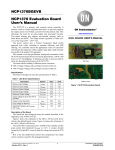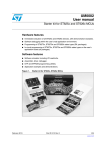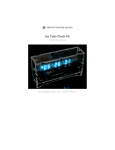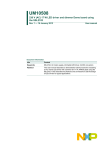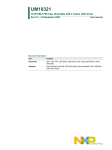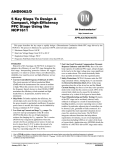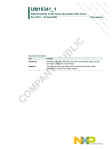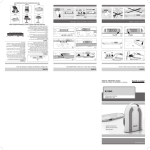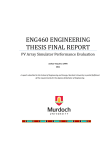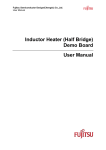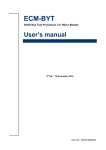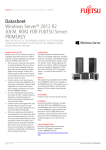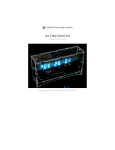Download UM10342 SSL2101 3 W mains dimmable buck board
Transcript
UM10342 SSL2101 3 W mains dimmable buck board Rev. 01 — 28 September 2009 User manual Document information Info Content Keywords SSL2101, LED driver, AC/DC conversion, dimmable, mains supply, driver, user manual Abstract This is a user manual for the SSL2101 3 W mains dimmable buck driver demo boards. UM10342 NXP Semiconductors SSL 2101 3 W buck board Revision history Rev Date Description 01 20090928 First issue Contact information For more information, please visit: http://www.nxp.com For sales office addresses, please send an email to: [email protected] UM10342_1 User manual © NXP B.V. 2009. All rights reserved. Rev. 01 — 28 September 2009 2 of 16 UM10342 NXP Semiconductors SSL 2101 3 W buck board 1. Introduction The next advance in LED illumination technology requires the optimum use of the maximum potential LED lumen output, enabled at an optimum energy efficiency and form factor. The NXP AC/DC converter dimmable board supports triac and transistor based dimmers. Deep dimming has been included to increase dimming ratio up to 1:350. Also, a combination of steering methods reduces audible transformer noise and creates a logarithmic dimming curve. The curve approaches the natural dimming curve in brightness as experienced with incandescent lamps. To provide a cost and size effective thermal design, temperature feedback is incorporated in the boards. This will allow tighter margins in optimization and more effective use of available LED power. The design gives an example of how to make a drive that is suitable for small form factor applications like retrofit lamps. 2. Safety warning The board needs to be connected to mains voltage. Touching the board during operation must be avoided at all times. An isolated housing is obligatory when used in uncontrolled, non-laboratory environments, so a galvanic isolation of the mains supply using a variable transformer is always recommended. These devices can be recognized by the symbols shown in Figure 1 a. Isolated Fig 1. b. Not Isolated Variac isolation symbols 3. Connecting the board The board can be optimized for either a 230 V (AC) 50 Hz or a 120 V (AC) 60 Hz mains source. Besides the mains source optimization the board has been designed to work with a several types and configurations of high power LEDs. The dimming performance may decrease if the board is used at a different mains voltage. UM10342_1 User manual © NXP B.V. 2009. All rights reserved. Rev. 01 — 28 September 2009 3 of 16 UM10342 NXP Semiconductors SSL 2101 3 W buck board 230 V AC Driver-Board X5 Light Dimmer 1 2 3 4 R1 TLM V2 V1 V3 L1 − C3 − LED load L2 + V4 + C4 014aaa924 Fig 2. Board connection diagram • Connect the mains line and the dimmer as shown in Figure 2. The dimmer unit can be placed on either input lead. If a galvanic isolated transformer is used, this should be placed in between the AC source and the dimmer/demo board. • Connect the load to the right side of the driver board using the side connectors. Attach a jumper on the connector X5, according to load configuration. Remark: When the board is placed in a metal enclosure, the middle pin of connector K1 can be connected to the metal casing for grounding. Remark: There should always be one load board with end terminations. At open output, and with power applied, the driver board might be damaged due to an overvoltage on C4. No output overvoltage protection is implemented. 4. Specifications Table 1 gives the specifications for the SSL2101 3 W LED buck board Table 1. Specifications Parameter Conditions Comment AC line input voltage 85 V (AC) to 276 V (AC) Board has been optimized for 230 V (AC) or 120 V (AC) ± 10 % variation Output voltage (LED voltage) 3.5 V (DC) to 60 V (DC) Board has been optimized for 19.5 V (DC) Output current (LED current) 20 mA to 700 mA Board has been optimized for 250 mA Output current accuracy +4 % to −4 % at 230 V (AC) ± 10 % Based on 250 mA, 6 W Maximum output power (LED power) 9W Using 9 × 1 W LED, 350 mA Efficiency without dimmer Typically 66 % Using 6 × 1 W LED, 250 mA Power Factor: 230 V (AC) 0.72 At 6 W output power UM10342_1 User manual © NXP B.V. 2009. All rights reserved. Rev. 01 — 28 September 2009 4 of 16 UM10342 NXP Semiconductors SSL 2101 3 W buck board Table 1. Specifications …continued Parameter Conditions Comment Switching frequency 37 kHz Can be adjusted, see Section 7.1 Dimming range 0.3 % to 100 % - Board dimensions 75 mm × 50 mm × 20 mm L×B×H Operating temperature 0° C to 85° C - 5. Board photos Fig 3. Driver board (top) UM10342_1 User manual © NXP B.V. 2009. All rights reserved. Rev. 01 — 28 September 2009 5 of 16 UM10342 NXP Semiconductors SSL 2101 3 W buck board Fig 4. Driver board (bottom) 6. Dimmers Several triac based dimmers have been tested by NXP Semiconductors. As different dimmers have different specifications the dimming performance of the board might vary. Dimming performance optimization can be achieved by tuning components (see Section 8). Dimmer compatibility is reached through a combination of sensing and control logic in combination with internal switches and external resistors. 7. Functional description 7.1 Converter operation On the buck demo board, a non-isolated buck converter is used to drive the LEDs. The SSL2101 can be used in two modes, DCM (Discontinuous Conduction Mode) and BCM (Boundary Conduction Mode). It is not suitable for CCM (Continuous Conduction Mode). DCM mode and BCM mode have the advantage over CCM that the switch losses at turn-on are minimal because no current is running. Also, the inductive material is used over the available BH curve because no permanent field is present. Connector X5 pin 1 can be used to monitor inductor and switch current. The peak current is limited using a sense resistor connected to the source pin. The OCP-limit is reached when the voltage at the source pin reaches 0.5 Volt. Three time slots can be distinguished: • t1 - This is the time required to build up the magnetic field in the inductor. UM10342_1 User manual © NXP B.V. 2009. All rights reserved. Rev. 01 — 28 September 2009 6 of 16 UM10342 NXP Semiconductors SSL 2101 3 W buck board • t2 - This is the time required to reduce the magnetic field in the inductor. • t3 - This is the time that no current flows through the inductor. Imax I = t × Vprim/L Ip = f(t) I = t × (Vsec + Vd)/L Vprim/L t1 t2 t --> Fig 5. t3 t1 + t2 + t3 = T = 1/f Converter operation Because t2 depends on LED voltage, t3 will change at fixed frequency and fixed voltage. The demo board is optimized for a load board with 6 LEDs. To achieve maximum power output (at BCM), or to avoid CCM mode (at low VLED) C7 can be tuned up or down leading to a change in base oscillator frequency. UM10342_1 User manual © NXP B.V. 2009. All rights reserved. Rev. 01 — 28 September 2009 7 of 16 UM10342 NXP Semiconductors SSL 2101 3 W buck board 7.2 Dimming curve Using a resistive divider and low-pass filter, consisting of R2, R3, R10, R11 and R21 and C6, a DC voltage is created from the rectified mains voltage. This DC voltage is used as a reference for the dimming position of the attached dimmer. The voltage is connected with the BRIGHTNESS and PWMLIMIT pin of the SSL2101. These pins influence output power, by restricting the duty-factor of the converter (PWMLIMIT) and frequency of the converter (brightness). They are sensitive in the range of 0.4 V to 2.5 V. By tuning the divider circuit, dimming steepness and lower threshold can be tuned. Bear in mind that at upper range, both pins should be high enough to obtain full output power, if input voltage independent current stabilization is to be achieved. 300 V (AC) 250 200 Vpwm-I Freq 150 Vbright "Comb" 100 50 0 0 0.5 0.7 0.9 1.1 1.3 1.5 1.7 1.9 2.1 2.3 3 V (DC) Fig 6. BRIGHTNESS pin and sensitivity 8. Board optimization You can do the following modifications on the demo board in order to meet specific customer application specifications: 8.1 Change output current Header X5 on the driver board can be used to tune the output current through the LED's. Table 2 shows measured current versus number of LEDs: UM10342_1 User manual © NXP B.V. 2009. All rights reserved. Rev. 01 — 28 September 2009 8 of 16 UM10342 NXP Semiconductors SSL 2101 3 W buck board Table 2. LED current configuration Jumper position 9 × 1 W (mA) 6 × 1 W (mA) 3 × 1 W (mA) None 85 120 220 1 to 2 150 215 390 2 to 3 125 185 340 3 to 4 250 360 640 1 to 2 and 3 to 4 320[1] 465[1] 810[1] [1] The coil L4 starts to saturate due to high peak current. 8.2 Changing oscillator frequency The dimming range of the demo board is partly determined by the oscillation circuit, made up of C7, R12 and R13. The frequency ratio can be calculated with the min and max 1 oscillator frequencies as follows: f min = -------------------------------2 × R12 × C7 1 f max = -------------------------------2 × R13 × C7 f min Frequency range = --------f max fmax is limited to 200 kHz. C7 is limited to a maximum of 1 nF. 9. Thermal lumen management The demo board provides an extra connector for thermal lumen management. For instance, a Negative Temperature Coefficient (NTC) resistor (thermistor) mounted in proximity of the LEDs can be used as sensor. Then, using a current mirror, the value is compared with reference resistor, and at threshold, the PWMLIMIT pin is pulled to GND. By variation of the resister value, the temperature at which stabilization occurs can be set. A lower value will cause higher threshold. Because of thermal resistance versus required galvanic isolation, a temperature difference will occur. If the board is used in free air conditions, this will lead to relative higher LED temperatures. In an enclosed housing, this difference will be smaller. UM10342_1 User manual © NXP B.V. 2009. All rights reserved. Rev. 01 — 28 September 2009 9 of 16 UM10342 NXP Semiconductors SSL 2101 3 W buck board 10. Driver board schematic To DIMMER 1 Vrectmains Fusistor 10 Ω To LEDS Vbuf X6 R1 L1 V3 V1 DBL205G HER107 X7 L1 L2 2.2 mH 800 Ω at 100 MHz LED+ MAINS 2 3 GND RGND − + C1 470 pF, 1 KV N X1 TEST 1 2 R2 750 kΩ R4 22 kΩ, 1W R6 1 kΩ, 1W R3 750 kΩ R5 22 kΩ, 1W R7 1 kΩ, 1W WBLEED LED+ C3 470 nF 400 V C2 470 nF 400 V V2 P6KE400A R9 R8 33 kΩ, 1W 33 kΩ, 1W LED VCC SBLEED C5 4.7 μF, 50 V GND 3 VCC 4 PWMLIMIT 5 BRIGHTNESS 6 RC2 7 RC 8 L3 50 Ω at 4 to 100 MHz V5 BZX85-C24 L4 310 μH RM6 LED+ LED LED− LED LED− LED LED− X2 A1 X4 R21 PWMLIMIT 0Ω R10 15 kΩ C4 4.7 μF 63 V V4 HER307 R13 R12 100 kΩ 5.6 kΩ SBLEED 1 WBLEED 2 VCC 3 GND 4 GND C8 5 100 pF BRIGHTNESS 6 RC2 7 RC 8 DRAIN 16 15 14 SSL2101T 13 12 11 10 9 DRAIN GND To TLM X8 GND GND SOURCE SOURCE VCC X9 AUX R18 1Ω ISENS PWMLIMIT R19 1Ω PWMLIMIT Rsence 1 GND 2 C6 10 uF, 16 V R11 10 kΩ RC RGND C7 680 pF, 50 V Fig 7. R16 R17 3 39 kΩ 2.2 kΩ 4 R14 R15 100 Ω 100 Ω RGND RC2 R20 2.2 Ω X3 ×5 Driver board schematic 11. Bill Of Materials (BOM) Table 3. Bill of materials 230 V (AC) Part Qty Ref design Part no Value Tol. (%) Package Type Manuf. 1 1 A1 - - SO16 SSL2101T NXP 2 1 C1 Capacitor 470 pF; 1 kV - - DEBB33A471 MUR 3 2 C2, C3 Capacitor 470 nF; 400 V 10 15 mm 2222 468 28474 VIS 4 1 C4 Capacitor 4.7 μF; 63 V 10 7.5 mm B32560J475K EPC 5 1 C5 Capacitor 4.7 μF; 50 V 10 1210 GRM32ER71H475KA88L MUR 6 1 C6 Capacitor 10 μF; 16 V 10 1206 GRM31CR61C106KC31L MUR 7 1 C7 Capacitor 680 pF; 50 V 10 0805 C0805C681J5GAC KEM 8 1 C8 Capacitor 100 pF, 100 V 5 0805 B37940K1101J60 EPC 9 1 L1 Inductor 2.2 mH 10 - RLB9012-222KL BRN 10 1 L2 Ferrite 800 Ω; 100 MHz - - 7427501 SCN 11 1 L3 Ferrite 50 Ω at 4 Mhz to 100 Mhz - - BL02RN2R1M2B MUR 12 1 L4 Inductor 310 μH - - custom - 14 1 R1 Resistor Fusistor 10 Ω - - NFR25H0001009JA100 VIS IC UM10342_1 User manual © NXP B.V. 2009. All rights reserved. Rev. 01 — 28 September 2009 10 of 16 UM10342 NXP Semiconductors SSL 2101 3 W buck board Table 3. Bill of materials 230 V (AC) …continued Part Qty Ref design Part no Value Tol. (%) Package Type Manuf. 15 PHY 2 R2, R3 Resistor 750 kΩ 1 1206 2322 724 67504L 16 2 R4, R5 Resistor 22 kΩ; 1 W 1 2512 CRCW251222K0FKEG-ND VIS 17 2 R6, R7 Resistor 1 kΩ; 1 W 1 2512 541-1.00KAFCT-ND 18 2 R8, R9 Resistor 33 kΩ; 1 W 1 2512 CRCW251233K0FKEG-ND VIS 19 1 R10 Resistor 15 kΩ 1 0805 2322 734 61503L PHY 20 1 R11 Resistor 10 kΩ 1 0805 2322 734 61003L PHY 21 1 R12 Resistor 100 kΩ 1 0805 2322 734 61004L PHY 22 1 R13 Resistor 5.6 kΩ 1 0805 2322 734 65602L PHY 23 2 R14, R15 Resistor 100 Ω; 1 W 1 2512 541-100AFTR-ND VIS VIS 24 1 R16 Resistor 39 kΩ 1 0805 2322 734 63903L PHY 25 1 R17 Resistor 2.2 kΩ 1 0805 2322 734 62202L PHY 26 2 R18, R19 Resistor 1Ω 1 1206 2322 724 61008L PHY 27 1 R20 Resistor 2.2 Ω 1 1206 2322 724 62208L PHY 28 1 R21 Resistor 0Ω - 0805 2322 730 91002L PHY 29 1 V1 Bridge Recitfier - - DIP4 Long DBL205G TAI 30 1 V2 TVS Diode 400 V; 600 W - DO-15 P6KE400A FAI 31 1 V3 Diode - - DO-41 HER107 MLC 32 1 V4 Diode - - DO201AD HER307 MLC 33 1 V5 Zener Diode 24 V - SOT23 BZX84C24 NXP 34 1 X1 Connector MSTB 2,5/ 3-G-5,08 - - 1759020 PHC 35 1 X2 Connector Socket 6 - SIL6_2.54 mm 972-8880 - 36 1 X3 Connector Socket 3 - SIL3_2.54 mm 972-8880 - 37 1 X4 Connector header 8 - SIL8 8280200-08-02 - Connector header 4 - SIL4 8280200-04-02 - TP - - - - 38 1 X5 39 5 X6, X7, X8, Test Point X9, X10 Table 4. Bill of materials 120 V (AC) Part Qty Ref design Part no Value Tol. (%) Package Type Manuf. 1 1 A1 IC - - SO16 SSL2101T/N1,515 NXP 2 1 C1 Capacitor 470 pF; 1 kV - - DEBB33A471 MUR 3 2 C2, C3 Capacitor 470 nF; 400 V 10 15 mm 2222 468 28474 VIS 4 1 C4 Capacitor 4.7 μF; 63 V 10 7.5 mm B32560J475K EPC 5 1 C5 Capacitor 4.7 μF; 50 V 10 1210 GRM32ER71H475KA88L MUR 6 1 C6 Capacitor 10 μF; 16 V 10 1206 GRM31CR61C106KC31L MUR 7 1 C7 Capacitor 680 pF; 50 V 10 0805 C0805C681J5GAC KEM 8 1 C8 Capacitor 100 pF; 100 V 5 0805 B37940K1101J60 EPC 9 1 L1 Inductor 2.2 mH 10 - RLB9012-222KL BRN UM10342_1 User manual © NXP B.V. 2009. All rights reserved. Rev. 01 — 28 September 2009 11 of 16 UM10342 NXP Semiconductors SSL 2101 3 W buck board Table 4. Bill of materials 120 V (AC) …continued Part Qty Ref design Part no Value Tol. (%) Package Type Manuf. 10 1 L2 Ferrite 800 Ω at 100 MHz - - 7427501 SCN 11 1 L3 Ferrite 50 Ω at 4 MHz to 100 Mhz - - BL02RN2R1M2B MUR 12 1 L4 Inductor 310 μH - - custom - 14 1 R1 Resistor Fusistor 10 Ω - - NFR25H0001009JA100 VIS PHY 15 2 R2, R3 Resistor 360 kΩ 1 1206 2322 724 63604L 16 2 R4, R5 Resistor 22 kΩ; 1 W 1 2512 CRCW251222K0FKEG-ND VIS 17 2 R6, R7 Resistor 1 kΩ; 1 W 1 2512 541-1.00KAFCT-ND 18 1 R8 Resistor 33 kΩ; 1 W 1 2512 CRCW251233K0FKEG-ND VIS VIS 19 1 R9 Resistor 0Ω 1 2512 - - 20 1 R10 Resistor 15 kΩ 1 0805 2322 734 61503L PHY 21 1 R11 Resistor 10 kΩ 1 0805 2322 734 61003L PHY 22 1 R12 Resistor 100 kΩ 1 0805 2322 734 61004L PHY 23 1 R13 Resistor 56 kΩ 1 0805 2322 734 65602L PHY 24 2 R14, R15 Resistor 100 Ω; 1 W 1 2512 541-100AFTR-ND VIS 25 1 R16 Resistor 39 kΩ 1 0805 2322 734 63903L PHY 26 1 R17 Resistor 2.2 kΩ 1 0805 2322 734 62202L PHY 27 2 R18, R19 Resistor 1.0 Ω 1 1206 2322 724 61008L PHY 28 1 R20 Resistor 2.2 Ω 1 1206 2322 724 62208L PHY 29 1 R21 Resistor 15 kΩ 1 0805 2322 734 61503L PHY 30 1 V1 Bridge Recitfier - - DIP4 Long DBL205G TAI 31 1 V2 TVS Diode 400 V; 600 W - DO-15 P6KE400A FAI 32 1 V3 Diode - - DO-41 HER107 MLC 33 1 V4 Diode - - DO201AD HER307 MLC 34 1 V5 Zener Diode 24 V - SOT23 BZX84C24 NXP 35 1 X1 Connector MSTB 2,5/ 3-G-5,08 - - 1759020 PHC 36 1 X2 Connector Socket 6 - SIL6_2.54 mm 972-8880 - 37 1 X3 Connector Socket 3 - SIL3_2.54 mm 972-8880 - 38 1 X4 Connector header 8 - SIL8 8280200-08-02 - 39 1 X5 Connector header 4 - SIL4 8280200-04-02 - 40 5 X6, X7, X8, Test Point X9, X10 - - - - - UM10342_1 User manual © NXP B.V. 2009. All rights reserved. Rev. 01 — 28 September 2009 12 of 16 UM10342 NXP Semiconductors SSL 2101 3 W buck board 12. Inductor specification Figure 8 shows the inductor schematic: 2 N1 5 Fig 8. Inductor schematic 12.1 Winding specification Table 5. No. Winding specification Section Wire Layers Turns Pin Begin End 1 N1 1 × 0.4 3 30 2 5 2 ISO 0.2 - - - - 12.2 Electrical characteristics Table 6. Inductance Section Inductance N1 310 μH ± 5 %, at 1 A 12.3 Core and bobbin • Core: RM6, 4-pin, air gap adjust on value N1 (310 μH) B65807-JR87 • Bobbin: B65808K-N1004-D1 • Clip: B65808A-2203X UM10342_1 User manual © NXP B.V. 2009. All rights reserved. Rev. 01 — 28 September 2009 13 of 16 UM10342 NXP Semiconductors SSL 2101 3 W buck board 12.4 Physical dimensions Fig 9. Transformer dimensions UM10342_1 User manual © NXP B.V. 2009. All rights reserved. Rev. 01 — 28 September 2009 14 of 16 UM10342 NXP Semiconductors SSL 2101 3 W buck board 13. Legal information 13.1 Definitions Draft — The document is a draft version only. The content is still under internal review and subject to formal approval, which may result in modifications or additions. NXP Semiconductors does not give any representations or warranties as to the accuracy or completeness of information included herein and shall have no liability for the consequences of use of such information. Suitability for use — NXP Semiconductors products are not designed, authorized or warranted to be suitable for use in medical, military, aircraft, space or life support equipment, nor in applications where failure or malfunction of a NXP Semiconductors product can reasonably be expected to result in personal injury, death or severe property or environmental damage. NXP Semiconductors accepts no liability for inclusion and/or use of NXP Semiconductors products in such equipment or applications and therefore such inclusion and/or use is at the customer’s own risk. Applications — Applications that are described herein for any of these products are for illustrative purposes only. NXP Semiconductors makes no representation or warranty that such applications will be suitable for the specified use without further testing or modification. 13.2 Disclaimers General — Information in this document is believed to be accurate and reliable. However, NXP Semiconductors does not give any representations or warranties, expressed or implied, as to the accuracy or completeness of such information and shall have no liability for the consequences of use of such information. Right to make changes — NXP Semiconductors reserves the right to make changes to information published in this document, including without limitation specifications and product descriptions, at any time and without notice. This document supersedes and replaces all information supplied prior to the publication hereof. Export control — This document as well as the item(s) described herein may be subject to export control regulations. Export might require a prior authorization from national authorities. 13.3 Trademarks Notice: All referenced brands, product names, service names and trademarks are the property of their respective owners. UM10342_1 User manual © NXP B.V. 2009. All rights reserved. Rev. 01 — 28 September 2009 15 of 16 UM10342 NXP Semiconductors SSL 2101 3 W buck board 14. Contents 1 2 3 4 5 6 7 7.1 7.2 8 8.1 8.2 9 10 11 12 12.1 12.2 12.3 12.4 13 13.1 13.2 13.3 14 Introduction . . . . . . . . . . . . . . . . . . . . . . . . . . . . 3 Safety warning . . . . . . . . . . . . . . . . . . . . . . . . . . 3 Connecting the board . . . . . . . . . . . . . . . . . . . . 3 Specifications. . . . . . . . . . . . . . . . . . . . . . . . . . . 4 Board photos . . . . . . . . . . . . . . . . . . . . . . . . . . . 5 Dimmers . . . . . . . . . . . . . . . . . . . . . . . . . . . . . . . 6 Functional description . . . . . . . . . . . . . . . . . . . 6 Converter operation . . . . . . . . . . . . . . . . . . . . . 6 Dimming curve . . . . . . . . . . . . . . . . . . . . . . . . . 8 Board optimization . . . . . . . . . . . . . . . . . . . . . . 8 Change output current . . . . . . . . . . . . . . . . . . . 8 Changing oscillator frequency . . . . . . . . . . . . . 9 Thermal lumen management . . . . . . . . . . . . . . 9 Driver board schematic . . . . . . . . . . . . . . . . . . 10 Bill Of Materials (BOM) . . . . . . . . . . . . . . . . . . 11 Inductor specification . . . . . . . . . . . . . . . . . . . 13 Winding specification . . . . . . . . . . . . . . . . . . . 13 Electrical characteristics . . . . . . . . . . . . . . . . . 13 Core and bobbin . . . . . . . . . . . . . . . . . . . . . . . 13 Physical dimensions . . . . . . . . . . . . . . . . . . . . 14 Legal information. . . . . . . . . . . . . . . . . . . . . . . 15 Definitions . . . . . . . . . . . . . . . . . . . . . . . . . . . . 15 Disclaimers . . . . . . . . . . . . . . . . . . . . . . . . . . . 15 Trademarks. . . . . . . . . . . . . . . . . . . . . . . . . . . 15 Contents . . . . . . . . . . . . . . . . . . . . . . . . . . . . . . 16 Please be aware that important notices concerning this document and the product(s) described herein, have been included in section ‘Legal information’. © NXP B.V. 2009. All rights reserved. For more information, please visit: http://www.nxp.com For sales office addresses, please send an email to: [email protected] Date of release: 28 September 2009 Document identifier: UM10342_1

















